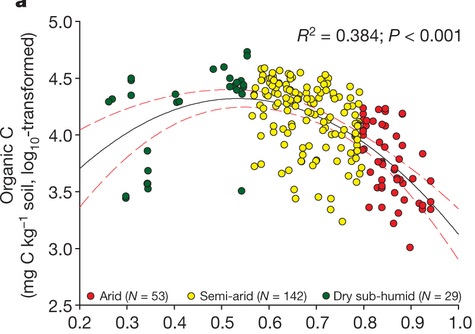How much carbon is stored in dryland soils?
November 19, 2013 – 5:00 pmDrylands are not known for massive soil carbon stocks like the Arctic tundra or plant carbon storage like tropical forests. However, drylands account for a large fraction of the terrestrial surface so they are still important when considering global carbon.
Many drylands biogeochemistry papers include statements like this one:
Arid, semiarid and dry-subhumid ecosystems (drylands) occupy 41% of the terrestrial surface, and account for ca. 25% of global soil organic carbon (C) reserves.
To put those numbers in context using the aridity index≤0.65 definition of drylands (numbers from Millenium Ecosystem Assessment):
Dryland: 41% of terrestrial surface
Hyperarid: 6.6%
Arid: 10.6%
Semiarid: 15.2%
Dry Subhumid: 8.7%
Frozen ground and Permafrost: 36%
Ice: 10%
Everything else (mostly forests): (23%)
Tropical Forests: 5% (used to be 2x more!)
All forests (overlaps with other categories, particularly boreal forest): 28%
When you follow the references back to their initial sources, you find that the carbon number (ca. 25% total global soil carbon) comes from large pedon databases with information on typically 3,000-10,000 soil profiles that were developed over several decades. Here’s an example. There is no reason to doubt these data, but they do have some limitations like several noted in Campbell et al. (2008):
The methods for estimating carbon storage vary widely, and no single method is considered highly accurate…The 1m depth is appropriate for this analysis, but likely underestimates carbon emissions from deeper peatland systems. No global dataset of peat depth is yet available.
This brings up an interesting point which is that the percentage might be a lot smaller if you account for Arctic peat and wetland C. From the most recent IPCC report:
The terrestrial biosphere reservoir contains carbon in organic compounds in vegetation living biomass (450–650 PgC; Prentice et al., 2001) and in dead organic matter in litter and soils (1500–2400 PgC; Batjes, 1996). There is an additional amount of old soil carbon in wetland soils (300–700 PgC; Bridgham et al., 2006) and in permafrost soils (see Glossary) (~1700 PgC; Tarnocai et al., 2009).
So if we count the additional carbon stocks in wetlands or permafrost, it could reduce that percentage of global soil carbon in drylands by about half, to ~13% of the global total.
The Tarnocai paper does point out though that 88% of that unaccounted-for carbon is totally frozen right now. Some of that may well defrost and mineralize to CO2, but a lot of it still won’t. How much defrosts remains to be seen as climate change progresses. On the other hand, most C in drylands is very close to the surface and thus potentially vulnerable to loss with climate change. A new study in Nature shows that dryland C is negatively correlated with aridity in semiarid and arid ecosystems, so as desertification continues, drylands seem likely to lose soil carbon:

In conclusion, current estimates of 25% global soil carbon in drylands come from soil profile data and the limitations of those data include (1) they are not necessarily collected with consistent methodology and (2) they generally don’t include carbon deeper than 1 m. Depending on whether you count old carbon in permafrost and wetlands, the total percentage of soil carbon in drylands may be more like 13%, or half of what is often cited. However, because dryland carbon is near the surface, it may still be vulnerable to loss with climate change.
Sorry, comments for this entry are closed at this time.